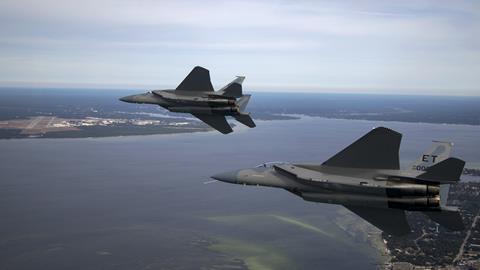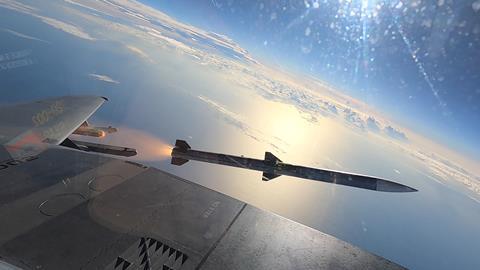Boeing is preparing to deliver the first combat-configured F-15EX Eagle II fighters to its US Air Force (USAF) customer.
The US airframer has already handed over six F-15EXs – the latest variant of the 1970s-era multi-role fighter – to the USAF, the type’s first and so far only customer.
However, those jets, built at Boeing’s St Louis plant in Missouri, were all configured for operational testing, currently under way at Eglin AFB in Florida with USAF test pilots.
But tail numbers seven and eight are fully operational combat aircraft. They will be received by the air force in the coming days.
“Those are on the ramp in St Louis,” says Rob Novotny, director of F-15 business development at Boeing. Those fighters will be assigned to an Air National Guard squadron in Portland, Oregon.

Plans at the Pentagon for F-15EX acquisition have repeatedly fluctuated, currently sitting at 104 aircraft for the USAF. The service had originally planned to buy 144 of the twin-engined fighters, but at one point cut the number to as few as 80 examples.
Boeing is still seeking its first overseas customer for the Eagle II, and the company is negotiating with Indonesia and Poland to secure a deal.
Israel is also reportedly considering a purchase of 25 F-15EXs, although that has not been confirmed by Boeing or the US government agency that manages foreign military sales.
Novotny says Boeing is in talks with all F-15 operators globally to gauge interest in the EX. That includes Singapore, whose air force flies 40 of the local configuration F-15SG fighters.
Although the Eagle II does not feature the stealth technology of fifth-generation fighters such as the Lockheed Martin F-35, the F-15EX does offer several advantages.
The jet’s twin GE Aerospace F110 engines give it a massive 13,300kg (29,500lb) payload capacity – including the ability to carry 12 air-to-air missiles underwing or three air-launched cruise missiles.
Compared to fifth-generation stealth fighters, the F-15EX is not limited by the need to carry weapons in low-observable internal bays.

To offset the F-15’s lack of stealth technology, Boeing and BAE Systems have developed an electronic warfare countermeasures system designed to make the fighter more survivable.
Boeing has previously suggested the F-15EX as an ideal complement to the F-35, which can better penetrate contested airspace, but has a smaller payload in stealth configuration.
Novotny describes the Eagle II as a platform based on “mature technology”, benefiting from the proven operational record of the F-15 family, which first entered service with the USAF in 1974.
Boeing is currently producing the F-15EX in a two-seat configuration, although the USAF plans to operate the type with just a single crew member.
Novotny says there has not yet been any interest from potential customers in producing a single-seat variant of the EX, although he says Boeing could do so.
While the back seat is currently set up for what Novotny describes as a traditional weapon systems operator, the former fighter pilot thinks the rear station offers great potential for controlling the swarms of so-called Collaborative Combat Aircraft (CCAs) the Pentagon hopes to rapidly develop.
“I think doing CCA activities in a single-seat platform is another task that becomes very complicated,” Novotny says.
He also notes the aircraft has the ability to accommodate new systems that have not yet been developed.
“What’s really cool about the F-15 is, as the weapons continued development, we have the computing power, we have the cooling, we have the real estate on the platform to bring more weapons, based on what the customer wants,” Novotny says.































